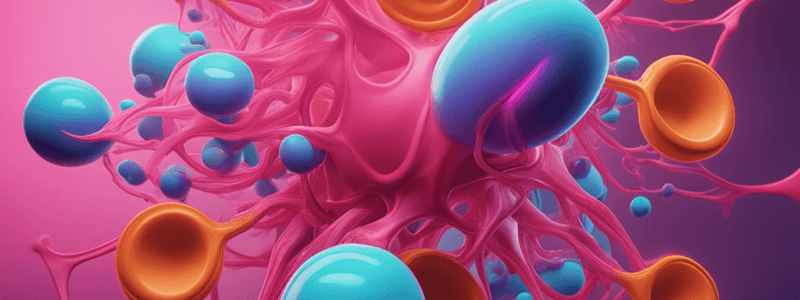Podcast
Questions and Answers
Where are sperm cells produced in humans?
Where are sperm cells produced in humans?
- Testes (correct)
- Scrotum
- Seminal vesicles
- Ovaries
What is the role of the female reproductive system in generating offspring?
What is the role of the female reproductive system in generating offspring?
- Facilitating fertilization (correct)
- Forming the scrotum
- Secreting testosterone
- Producing sperm cells
What is the outcome of the union of a sperm cell and an egg cell?
What is the outcome of the union of a sperm cell and an egg cell?
- Fetus
- Zygote (correct)
- Embryo
- Placenta
In which animals does external fertilization occur?
In which animals does external fertilization occur?
What process ensures genetic variation in offspring and the continuation of species?
What process ensures genetic variation in offspring and the continuation of species?
What is the main difference between sexual and asexual reproduction?
What is the main difference between sexual and asexual reproduction?
In which type of reproduction is genetic variation in offspring generated?
In which type of reproduction is genetic variation in offspring generated?
What is the defining characteristic of organisms that undergo asexual reproduction?
What is the defining characteristic of organisms that undergo asexual reproduction?
In the context of human reproduction, what process results in the formation of a zygote?
In the context of human reproduction, what process results in the formation of a zygote?
Which type of reproduction occurs in organisms possessing a single set of chromosomes?
Which type of reproduction occurs in organisms possessing a single set of chromosomes?
Flashcards are hidden until you start studying
Study Notes
Reproduction: Exploring Sexual, Asexual, Human, Reproductive Systems, and Fertilization
Reproduction, the biological process that ensures the continuation of species, is a complex and fascinating subject that encompasses various aspects involving the creation, growth, and maintenance of life. In this article, we will explore the subtopics of sexual and asexual reproduction, human reproduction, reproductive systems, and fertilization.
Sexual Reproduction
Sexual reproduction is the process that generates genetic variation in offspring, combining traits from both parents. It involves the fusion of sperm and egg cells in a process called fertilization to form a zygote, which later develops into a new individual. Sexual reproduction usually occurs in diploid organisms, possessing two sets of chromosomes (one from each parent).
Asexual Reproduction
Asexual reproduction is a simpler process in which offspring are created through mitosis, where a single organism duplicates its genetic material and creates a new individual without the involvement of gametes. This method occurs in haploid organisms, possessing a single set of chromosomes. Asexual reproduction is seen in single-cell organisms like bacteria and fungi and in some multicellular organisms like aphids.
Human Reproduction
Human reproduction is a sexual process, resulting in the formation of a zygote that develops into an individual. In humans, sperm cells are produced in the testes, while eggs are produced in the ovaries. Fertilization occurs when a sperm cell penetrates an egg cell, forming a zygote. A zygote undergoes mitosis to become an embryo, which later develops into an individual.
Reproductive Systems
The reproductive system is a specialized set of organs and structures that facilitate sexual reproduction. In males, the reproductive system includes the testes, scrotum, vas deferens, seminal vesicles, prostate gland, and penis. In females, the reproductive system includes the ovaries, uterus, fallopian tubes, and vagina. The female reproductive system plays a crucial role in generating eggs, facilitating fertilization, and nurturing the developing embryo.
Fertilization
Fertilization is the process where sperm and egg cells unite, forming a zygote. In most animals, fertilization occurs internally, with sperm cells traveling through the female reproductive system to meet the egg cell. In contrast, some species like sea urchins and some fish, fertilization occurs externally, with sperm and egg cells combining in the surrounding environment.
The process of fertilization is essential for sexual reproduction, ensuring genetic variation in offspring and the continuation of species. Understanding the complexities of human reproduction and reproductive systems allows us to appreciate the marvels of biology and the intricate processes that support life. As science advances, our knowledge of reproduction and fertility will continue to grow, offering new treatments and approaches to support human reproduction and well-being.
Studying That Suits You
Use AI to generate personalized quizzes and flashcards to suit your learning preferences.




